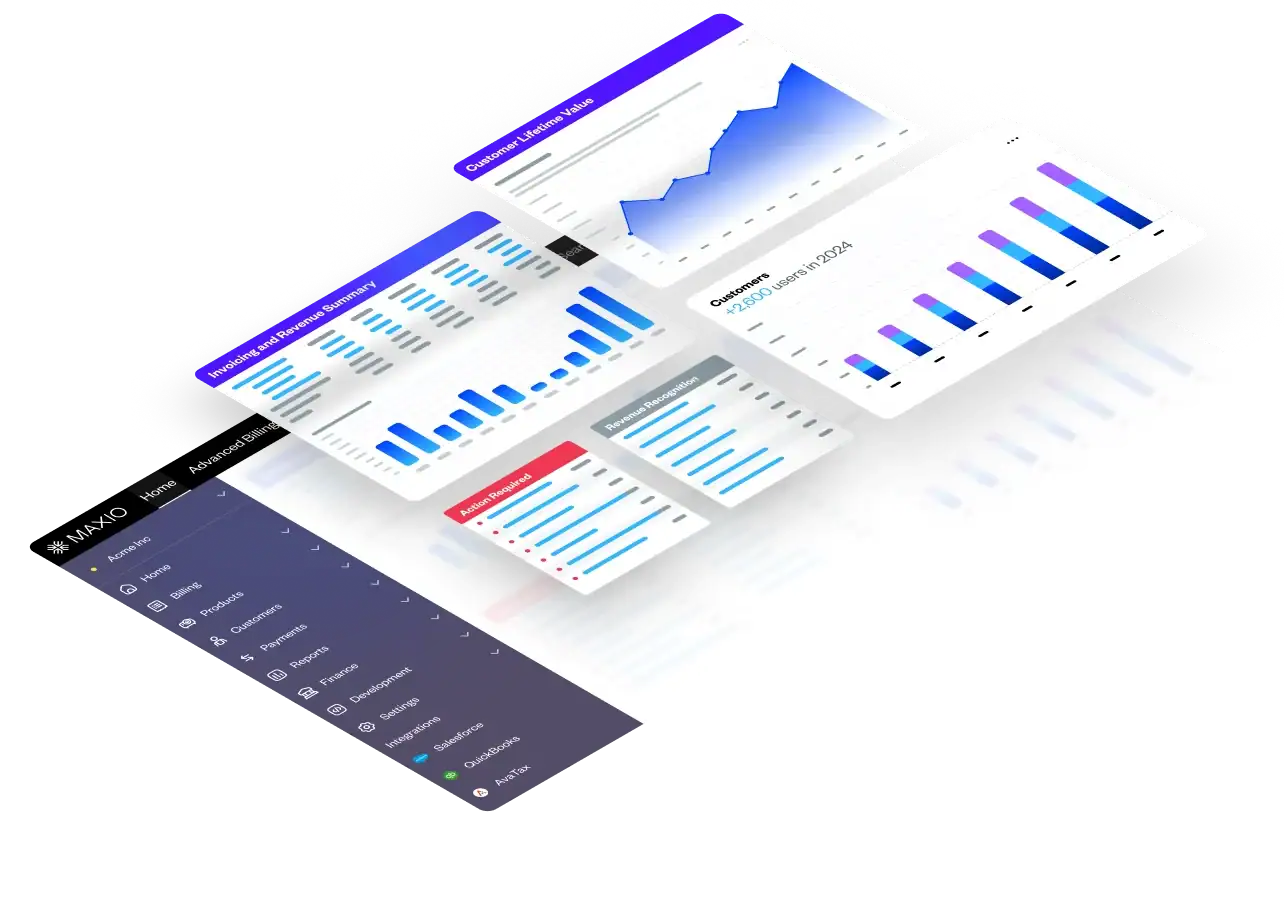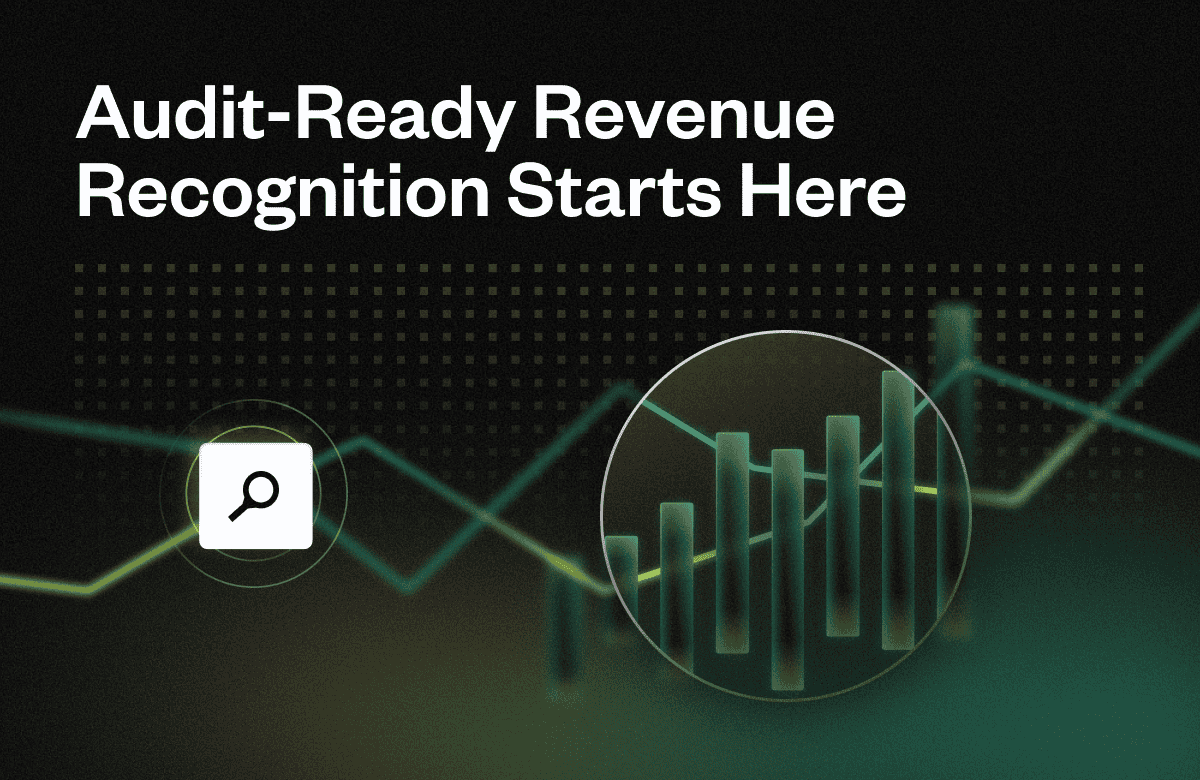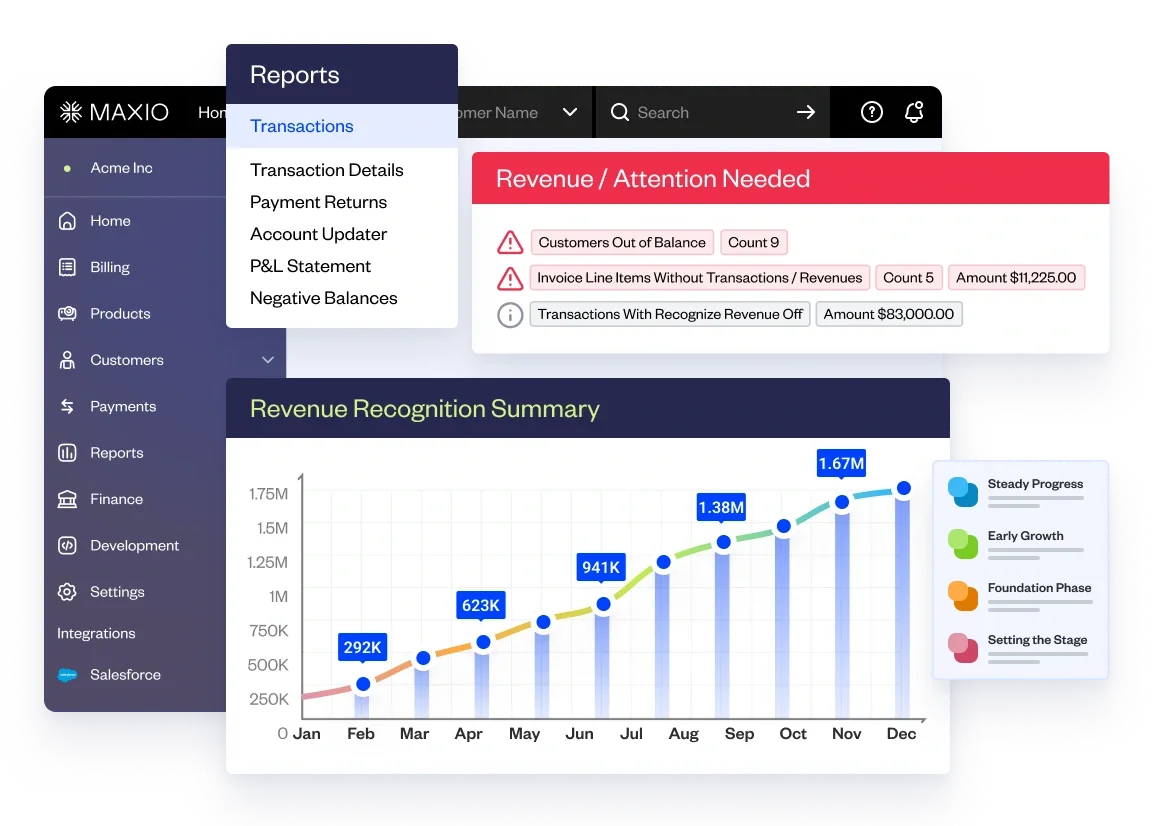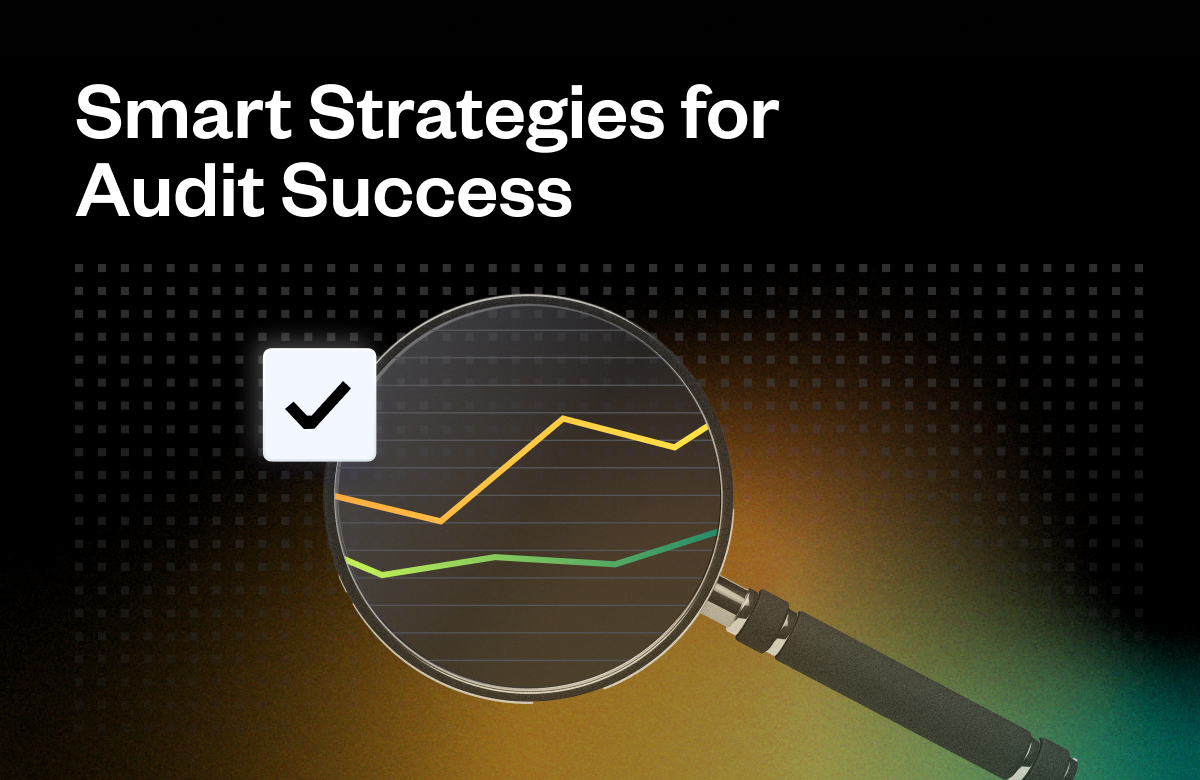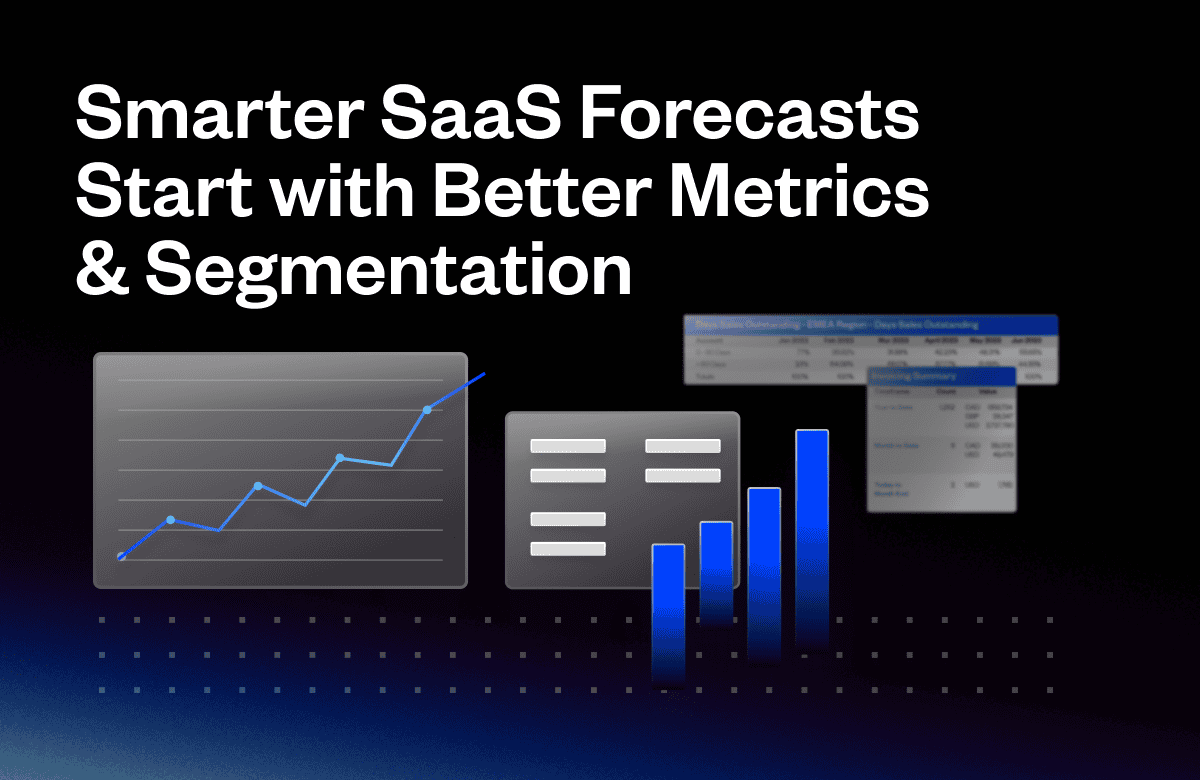Revenue recognition isn’t just an accounting footnote. For SaaS companies, it’s the line between clarity and chaos in your financial reporting.
Recognizing revenue at the right time (not just when cash hits the account) keeps your books clean, your investors confident, your business decisions grounded in reality, and your organization prepared for a smooth audit. Mess it up, and you’re looking at misreported earnings, compliance headaches, and a CFO who’s quietly screaming into a pillow.
That’s why, in this guide, we’ll break down:
- What revenue recognition actually means (in plain English)
- The key standards SaaS companies need to follow (hello, ASC 606 and IFRS 15)
- The different methods used to recognize revenue
- And real-world scenarios that show how all of this works in practice
If you’ve ever wondered how to handle an annual contract paid upfront, a usage-based billing model, or a refund request mid-subscription, you’re in the right place.
Let’s get into it.
What is revenue recognition?
Revenue recognition is the process of determining when a software company can officially count money as earned.
For SaaS businesses, this concept plays a critical role in financial reporting. Recognizing revenue too early (or too late) can distort your numbers, confuse your investors, and throw off your business model. It’s why standards exist in the first place—to ensure that financial statements reflect the real performance of a software company, not just the cash flow timing.
In short: if your business model relies on subscriptions, services, or multi-step deliverables, you need a plan for when and how to recognize revenue.
When SaaS businesses should recognize revenue
Timing is everything—and for SaaS companies, it gets complicated fast.
You’ve got deferred revenue sitting on the balance sheet from long-term contracts, customers prepaying for services that stretch across multiple accounting periods, and a billing cycle that rarely matches the delivery of value. Then, add in usage-based models or upfront onboarding, and now you’re juggling a dozen ways to mess it up.
The key to keeping your books clean? You need to set strict performance obligations.
Every customer contract spells out what you’ve promised to deliver. GAAP (Generally Accepted Accounting Principles) says you can’t recognize revenue until those performance obligations are satisfied—whether that’s providing access to your product, completing a milestone, or hitting a usage threshold.
That means your payment terms might say “pay now,” but your financial statements can’t reflect that revenue until the work is actually done.
Getting this right isn’t just about compliance—it’s about building a trustworthy business. Clean books lead to better decisions, smoother audits, and more confidence from your board, buyers, and future investors.
Want to make this easier (and automated)? You can learn more about Maxio’s automated revenue recognition reporting to see how SaaS companies are keeping their books balanced.
Revenue recognition standards explained
If you’re a SaaS company, you can’t just wing it when it comes to revenue recognition. Whether you’re reporting to your board, preparing for an audit, or just trying to make sense of your books, following the right revenue recognition standard is non-negotiable.
Two frameworks dominate the landscape: ASC 606 and IFRS 15. Together, they define when and how companies across the globe (and across industries) should recognize revenue. For SaaS businesses with recurring revenue, performance obligations, and multi-step delivery models, these standards provide much-needed structure.
So, where did they come from?
- IFRS 15 was introduced by the International Accounting Standards Board (IASB) as part of the broader International Financial Reporting Standards (IFRS).
- ASC 606 was issued by the Financial Accounting Standards Board (FASB) and forms part of the U.S. Generally Accepted Accounting Principles (GAAP).
Let’s break them down.
Overview of IFRS 15
IFRS 15 sets the global standard for how companies should recognize revenue from contracts with customers. Its goal? Consistency. Whether you’re selling shoes or software, the same five-step framework applies.
For SaaS companies, IFRS 15 provides clarity on how to account for complex billing arrangements, subscription renewals, and performance-based revenue streams—especially when serving customers across multiple countries.
If your business operates internationally (or falls under IFRS reporting), this is your playbook.
Overview of ASC 606
ASC 606 is the U.S. counterpart, developed by FASB. It’s designed to standardize financial reporting across industries and eliminate the patchwork of outdated revenue rules that existed before.
Under financial reporting ASC 606, SaaS businesses must identify performance obligations in each contract, determine a transaction price, and recognize revenue as those obligations are satisfied. This is especially important for companies with deferred revenue, usage-based pricing, or bundled services.
If your company is based in the U.S. or follows GAAP, ASC 606 is the standard you’ll need to follow to ensure accurate financial statements and long-term financial performance.
When to use IFRS 15 vs ASC 606
At a high level, IFRS 15 and ASC 606 are nearly identical—they were developed jointly by the IASB and FASB to create a unified approach to revenue recognition. Both follow the same five-step model and are built around honoring performance obligations in a customer contract.
But there are small technical differences—especially around disclosures and how contract modifications are handled. If you’re a public company operating globally, you may be dealing with both.
- Use IFRS 15 if you’re reporting under international standards or working in jurisdictions that require International Financial Reporting Standards.
- Use ASC 606 if you’re a U.S.-based company that must follow Generally Accepted Accounting Principles.
The stakes here are that a misalignment in the rev rec practices you’re using can lead to misstatements, poor investor confidence, or worse—a visit from the auditors.
Understanding the five-step revenue recognition process
Whether you’re navigating long-term contracts, bundling services, or collecting upfront payments, ASC 606 provides a clear playbook: the five-step revenue recognition process.
For SaaS businesses, this framework brings consistency to what can otherwise feel like a financial guessing game. It also ensures your financial statements reflect reality, and not just a pre-designed billing schedule.
Let’s walk through each step.
Step 1: Identify the customer contract
Everything starts with a customer contract—a written, verbal, or implied agreement that outlines rights, obligations, and payment terms. For SaaS companies, this could be anything from an annual subscription to a multi-year enterprise deal.
If you don’t have a valid contract, the rest of the process can’t begin.
Step 2: Identify the performance obligations
This step is about figuring out what exactly you’re promising to deliver. Each product or service in the contract that provides distinct value to the customer is considered a performance obligation.
For SaaS, these might include access to software, onboarding services, or periodic updates. Identifying these obligations correctly is key to recognizing revenue accurately.
Step 3: Determine the transaction price
The transaction price is the amount of consideration your company expects to receive from the customer. This sounds simple, but in SaaS, it can get messy with discounts, variable usage fees, or credits. It’s important to lock down the expected payment, especially for contracts with usage-based pricing or fluctuating billing terms.
Step 4: Allocate the transaction price to performance obligations
If your contract includes more than one deliverable (say, general software access vs. add-on modules), you need to split—or allocate—the total transaction price across each performance obligation based on its relative value.
This step ensures your revenue is recognized in proportion to the services actually being delivered.
Step 5: Recognize revenue
Here’s where the magic happens. Revenue can be recognized as each performance obligation is satisfied—whether at a point in time (e.g., delivering a one-time service) or over time (e.g., monthly access to a platform).
This step completes the revenue recognition process, aligning your books with your actual delivery of value.
Want a deeper dive? We’ve broken this all down in our five-step process for revenue recognition.
Common revenue recognition methods
Not every business recognizes revenue the same way. Your business model, payment terms, and industry norms all play a role in determining which method makes the most sense. For SaaS businesses, and especially subscription-based businesses, the focus is usually on methods that align revenue with the delivery of service over time.
But zooming out, here are the most common revenue recognition methods, how they work, and when they’re typically used:
- Completed Contract Method: Used mostly in long-term projects, this method delays all revenue recognition until the entire contract is fulfilled. It’s common in construction or project-based industries, but not ideal for SaaS, where services are delivered continuously.
- Cost Recovery Method: Revenue isn’t recognized until all costs have been recouped. It’s a conservative approach, often used when there’s uncertainty around collecting payment. Not typically seen in subscription-based businesses, but relevant in high-risk deals.
- Installment Method: Revenue is recognized as cash is collected over time. This method smooths out revenue recognition for contracts with extended payment terms, but doesn’t match well with prepaid SaaS contracts or recurring models.
- Percentage of Completion Method: Revenue is recognized gradually as a project progresses, based on how much work has been completed. This is often used in milestone-based contracts or long-term projects—and is occasionally applied in SaaS for custom implementations or add-on services tied to delivery phases.
- Point-in-Time Method: Revenue is recognized at a specific moment—usually when control of a product or service transfers to the customer. It’s a common fit for one-off services or purchases that don’t extend over multiple accounting periods.
- Proportional Performance Method: Revenue is recognized in proportion to the work completed. For SaaS, this is a solid match when services are delivered steadily over time, such as monthly access tied to a subscription fee.
- Sales-Basis Method: Revenue is recognized only at the point of sale. While simple, this doesn’t work for SaaS models with upfront payments or deferred delivery—it’s better suited for retail or transaction-based businesses.
Each of these methods has trade-offs in how they affect cash flow, compliance, and timing. If you’re looking for more detail on which models work best for SaaS businesses, we’ve broken it down further in our guide to SaaS revenue recognition methods.
Examples of revenue recognition for SaaS companies
There’s no one-size-fits-all answer when it comes to recognizing revenue. SaaS businesses face unique challenges based on their subscription model, payment terms, and the specifics of how they deliver value—whether that’s through usage, milestones, or something in between.
In the following revenue recognition examples, we’ll walk through seven common scenarios using fictional companies A-G and show how they apply different revenue recognition methods. Each one highlights how timing, billing models, and contract changes impact your financial statements, cash flow, and overall financial performance.
Annual subscription with payment upfront
Company A sells an annual subscription to its software platform for $12,000. Customers pay the full amount upfront, but the service is delivered evenly over 12 months.
Recognition Method: Proportional Performance Method
Although the full cash payment is collected at the start of the subscription period, Company A can’t recognize all $12,000 in one go. Instead, it must recognize $1,000 per month over the life of the contract, aligning revenue with service delivery.
This approach ensures that financial statements accurately reflect the company’s performance obligations, even when payment is received in advance.
Monthly subscription with recurring billing
Company B offers a $200/month plan for access to its project management platform. Customers are billed at the start of each month and gain access to the platform immediately.
Recognition Method: Point-in-Time Method
In this case, the revenue aligns neatly with the payment terms and subscription period. Company B recognizes $200 at the beginning of each month because the performance obligation, access to the platform, is fulfilled as soon as the service is made available.
And because the revenue is tied to short-term access and renews monthly, this is one of the simplest and cleanest revenue recognition examples.
It’s also the default setup for most SaaS businesses using a standard subscription model with no add-ons or delayed services.
This kind of recurring setup is easy to automate with Maxio’s automated recurring billing, which handles billing, revenue allocation, and reporting with zero spreadsheet wrangling.
Usage-based billing
Company C provides an API platform that charges customers based on the number of API calls made each month. The rate is $0.05 per call, and usage is tallied at the end of each billing cycle. In March, a customer uses 10,000 calls, triggering a $500 invoice.
Recognition Method: Sales-Basis Method
Because usage isn’t known until the end of the billing cycle, Company C can’t recognize revenue until the performance obligation—providing the API calls—is completed. Once usage is measured, revenue is recognized in full based on actual consumption.
This method is common for SaaS companies that rely on variable or usage based pricing models, where revenue can’t be reasonably estimated until after service delivery. Using a usage-based billing platform makes it easier to measure consumption accurately, align revenue with real product usage, and ensure reliable metrics in financial statements.
Milestone-based billing
Company D signs a $60,000 implementation contract with an enterprise client. The project is structured in phases, with billing and delivery tied to three key milestones: planning ($20,000), deployment ($20,000), and training ($20,000). Each milestone has defined deliverables and acceptance criteria.
Recognition Method: Percentage of Completion Method
Rather than recognizing revenue evenly over time, Company D recognizes revenue only as each milestone is completed. When the planning phase wraps and deliverables are approved, $20,000 is recognized. The same applies to each subsequent phase.
This method ensures revenue is matched with tangible delivery and satisfies performance obligations outlined in the contract. It’s particularly useful for long-term contracts with staged service delivery—common in enterprise SaaS implementations.
Contract modification or upsell
Company E initially signs a 12-month subscription contract with a customer for $1,000/month. Six months in, the customer upgrades to a higher tier at $1,500/month, effective immediately. The original contract is amended to reflect the new pricing and additional features.
Recognition Method: Modified Contract Allocation (per ASC 606)
Because this is a contract modification, Company E must reassess its performance obligations and allocation of the remaining transaction price. Under ASC 606, if the new services are distinct from those previously delivered, the upgrade is treated as a separate contract layered onto the original.
Revenue from the original subscription continues as planned through the first six months. For the remaining six months, Company E recognizes $1,500/month, reflecting the higher tier. This preserves clean financial statements and ensures compliance with GAAP.
These kinds of mid-term changes are common scenarios in SaaS payments—and if not handled properly, they can create revenue distortions and downstream reporting issues.
Prepaid customer credit balance
Company F allows customers to prepay $10,000 into an account that can be drawn down over time for API usage, add-ons, or support services. Customers then use credits at their discretion, and usage varies from month to month.
Recognition Method: Cost Recovery or Sales-Basis Method (depending on usage visibility)
Because the subscription model doesn’t guarantee usage on a fixed schedule, Company F must recognize revenue only as credits are actually consumed—i.e., when the performance obligations tied to those credits are fulfilled.
In months with no usage, no revenue is recognized—even though cash is in hand. Then, as credits are used, revenue is recorded accordingly, ensuring financial statements reflect true delivery of value.
This model helps smooth out cash flow while aligning recognition with actual customer activity—a common scenario for flexible, pay-as-you-go SaaS offerings.
Refunds
Finally, Company G offers a $100/month SaaS plan with a 30-day money-back guarantee. A customer signs up, pays the first month, but cancels and requests a refund after 10 days due to onboarding delays.
Recognition Method: Reversal of Previously Recognized Revenue
In this scenario, Company G initially recognizes the $100 using the point-in-time method, assuming the performance obligation (platform access) begins at signup. But when the customer cancels and receives a full refund, the company must reverse the revenue previously recognized and adjust its financial statements.
Refund scenarios require careful tracking and timely adjustments to avoid overstatement of financial performance—especially for companies offering trial periods or flexible refund policies.
Proper handling of refunds also ensures compliance with GAAP and keeps internal metrics (like MRR and churn) accurate for reporting and forecasting.
Rely on Maxio for automation of the revenue recognition process
Revenue recognition shouldn’t feel like you’re assembling IKEA furniture without the manual. For SaaS businesses, especially startups scaling quickly, automating this process is the smartest way to stay compliant, accurate, and sane.
That’s why we built Maxio’s revenue recognition tools to handle the complexities of ASC 606, IFRS 15, and every quirky billing model in between. With real-time tracking, flexible configuration, and integrations across your stack, Maxio simplifies compliance and strengthens your income statement and accounts receivable process in one go.
You’ll reduce errors, improve your financial performance, and unlock better forecasting by aligning your revenue data with your actual delivery of value. Plus, all your core metrics—like MRR, deferred revenue, and recognized revenue—stay clean and audit-ready.
Ready to automate revenue recognition the right way? Get a demo.
